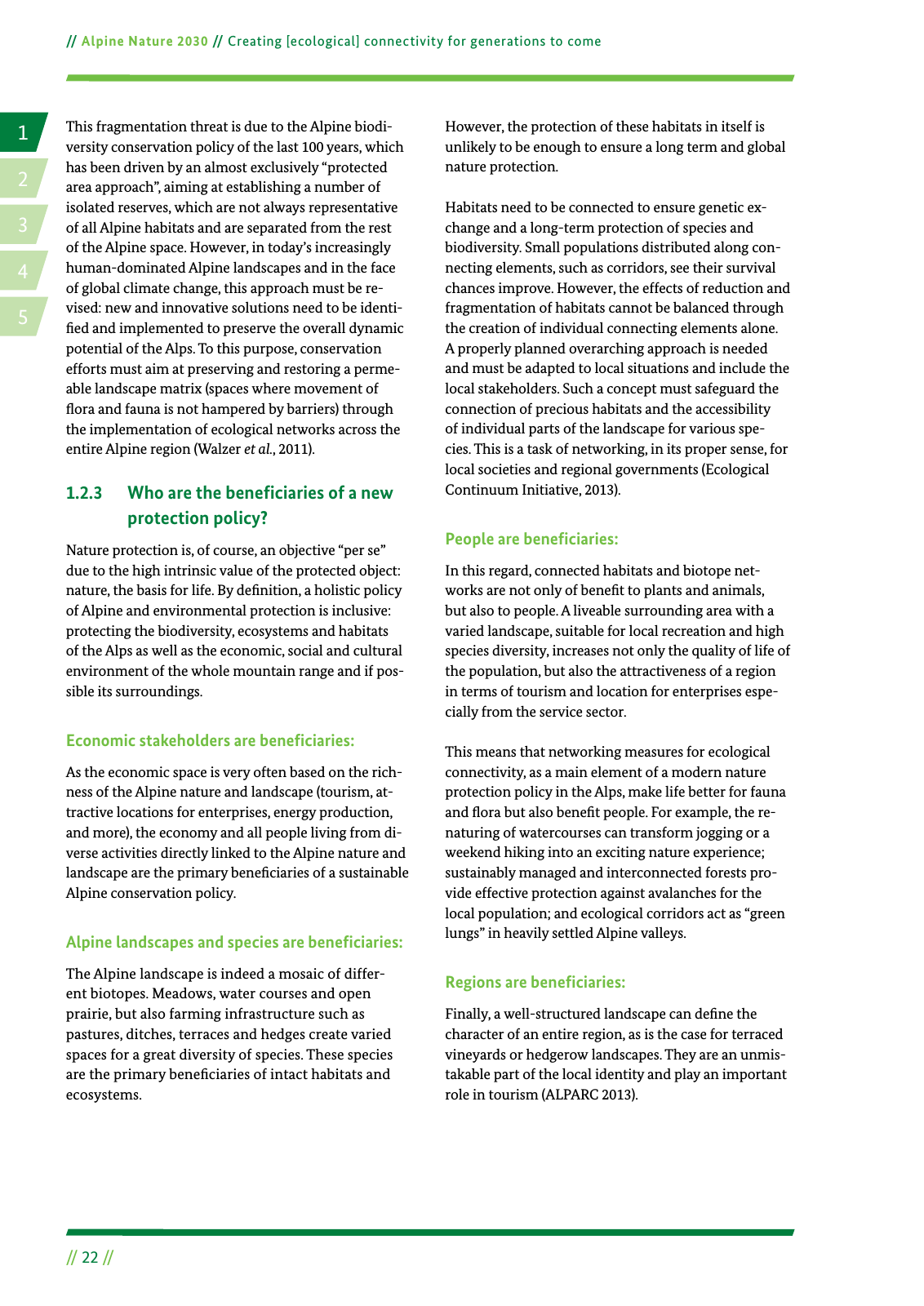14 2 5 3 22 Alpine Nature 2030 Creating ecological connectivity for generations to come This fragmentation threat is due to the Alpine biodi versity conservation policy of the last 100 years which has been driven by an almost exclusively protected area approach aiming at establishing a number of isolated reserves which are not always representative of all Alpine habitats and are separated from the rest of the Alpine space However in today s increasingly human dominated Alpine landscapes and in the face of global climate change this approach must be re vised new and innovative solutions need to be identi ed and implemented to preserve the overall dynamic potential of the Alps To this purpose conservation efforts must aim at preserving and restoring a perme able landscape matrix spaces where movement of ora and fauna is not hampered by barriers through the implementation of ecological networks across the entire Alpine region Walzer et al 2011 However the protection of these habitats in itself is unlikely to be enough to ensure a long term and global nature protection Habitats need to be connected to ensure genetic ex change and a long term protection of species and biodiversity Small populations distributed along con necting elements such as corridors see their survival chances improve However the effects of reduction and fragmentation of habitats cannot be balanced through the creation of individual connecting elements alone A properly planned overarching approach is needed and must be adapted to local situations and include the local stakeholders Such a concept must safeguard the connection of precious habitats and the accessibility of individual parts of the landscape for various spe cies This is a task of networking in its proper sense for local societies and regional governments Ecological Continuum Initiative 2013 People are beneªciaries In this regard connected habitats and biotope net works are not only of bene t to plants and animals but also to people A liveable surrounding area with a varied landscape suitable for local recreation and high species diversity increases not only the quality of life of the population but also the attractiveness of a region in terms of tourism and location for enterprises espe cially from the service sector This means that networking measures for ecological connectivity as a main element of a modern nature protection policy in the Alps make life better for fauna and ora but also bene t people For example the re naturing of watercourses can transform jogging or a weekend hiking into an exciting nature experience sustainably managed and interconnected forests pro vide effective protection against avalanches for the local population and ecological corridors act as green lungs in heavily settled Alpine valleys Regions are beneªciaries Finally a well structured landscape can de ne the character of an entire region as is the case for terraced vineyards or hedgerow landscapes They are an unmis takable part of the local identity and play an important role in tourism ALPARC 2013 1 2 3 Who are the beneªciaries of a new protection policy Nature protection is of course an objective per se due to the high intrinsic value of the protected object nature the basis for life By de nition a holistic policy of Alpine and environmental protection is inclusive protecting the biodiversity ecosystems and habitats of the Alps as well as the economic social and cultural environment of the whole mountain range and if pos sible its surroundings Economic stakeholders are beneªciaries As the economic space is very often based on the rich ness of the Alpine nature and landscape tourism at tractive locations for enterprises energy production and more the economy and all people living from di verse activities directly linked to the Alpine nature and landscape are the primary bene ciaries of a sustainable Alpine conservation policy Alpine landscapes and species are beneªciaries The Alpine landscape is indeed a mosaic of differ ent biotopes Meadows water courses and open prairie but also farming infrastructure such as pastures ditches terraces and hedges create varied spaces for a great diversity of species These species are the primary bene ciaries of intact habitats and ecosystems

Hinweis: Dies ist eine maschinenlesbare No-Flash Ansicht.
Klicken Sie hier um zur Online-Version zu gelangen.
Klicken Sie hier um zur Online-Version zu gelangen.